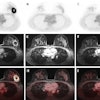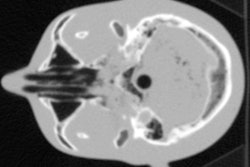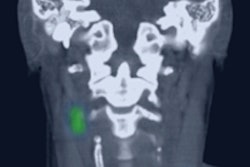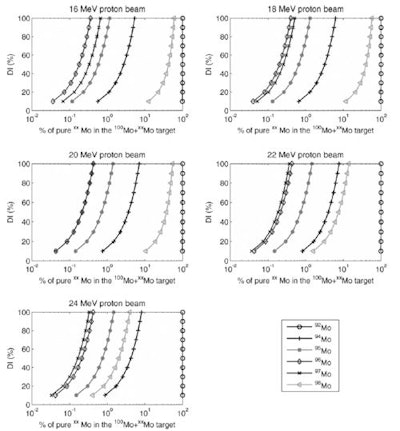
Radioisotope technetium-99m (Tc-99m) is traditionally obtained via the decay of molybdenum-99, which is produced in a small number of aging nuclear reactors. The fragility of this supply line has prompted the investigation of alternative manufacturing methods.
Technetium-99m (Tc-99m), a radioisotope used in up to 40 million diagnostic procedures each year, is traditionally obtained via the decay of molybdenum-99 (Mo-99), which is produced in a small number of aging nuclear reactors. The fragility of this supply line has prompted the investigation of alternative manufacturing methods, such as direct production of Tc-99m by bombarding a Mo-100 target with protons from a medical cyclotron.
This cyclotron-based approach could help solve the supply shortage. However, even when using highly enriched Mo-100 targets, remaining traces of other stable Mo isotopes will result in the creation of Tc radioisotopes other than Tc-99m. Injecting radiopharmaceuticals containing such impurities may lead to increased patient dose.
"One important factor that affects the amount of co-produced impurities is the composition of the molybdenum target. Therefore, before any production run, it is crucial to choose a target composition that will result in a dose increase below predefined limits," explained Xinchi Hou, from the University of British Columbia. "However, it is very difficult to select such target a priori. Yield and dosimetry calculations for each potential radioactive product can be performed, but this approach is very complicated and time consuming."
To simplify matters, Hou and colleagues, also from TRIUMF and the BC Cancer Agency, have developed an algorithm for estimating patient radiation dose based solely on the knowledge of target composition. The algorithm does not require yield and dosimetry estimations for each Tc isotope. Instead, it uses tabulated values of patient doses that would result from Tc produced from each of the seven stable Mo isotopes -- Mo-92, Mo-94, Mo-95, Mo-96, Mo-97, Mo-98, and Mo-100 -- that the target may contain (Physics in Medicine and Biology, 18 December 2015, Vol.61:2, pp. 542-553).
The researchers used in-house CYD (cyclotron production yields and dosimetry) software to calculate the patient effective doses for the different isotopes. By assuming a "worst-case irradiation-injection scenario," in which samples were produced using 12-hour irradiations and injected 24 hours later, they ensured that the dose increase (DI) would be overestimated if a shorter irradiation or earlier injection time was used.
The authors provide a table of all calculated effective patient doses in their paper (for three Tc-99m-based radiopharmaceuticals: sestaMIBI, phosphonate and pertechnetate). Using these tabulated values with the proposed algorithm enables estimation of patient dose and DI for any Mo target composition.
In depth analysis
To determine the upper limits for target impurities and identify the worst Mo offender, the researchers investigated how patient dose would increase if the target contained Mo-100 and one other Mo isotope. For five irradiation energies (16-24 MeV) and the same worst-case scenario, they plotted DI versus the percentage of each Mo isotope in the target.
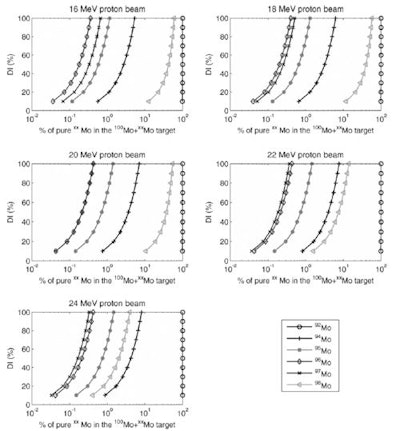 The dose increase (DI) due to the percentage amounts of each Mo isotope in a Mo-100 + Mo-xx target, for irradiation energies from 16 to 24 MeV. The targets were assumed thick enough to stop the proton beam; 12 hour irradiation and injection at 24 hour after irradiation were considered.
The dose increase (DI) due to the percentage amounts of each Mo isotope in a Mo-100 + Mo-xx target, for irradiation energies from 16 to 24 MeV. The targets were assumed thick enough to stop the proton beam; 12 hour irradiation and injection at 24 hour after irradiation were considered.This revealed that reactions on Mo-95-97 (producing Tc-94-96) contributed the most to patient dose and that doses from Tc isotopes produced on Mo-92-97 remained approximately constant with proton beam energy. The presence of Mo-98 did not significantly affect dose at energies below 20 MeV, but led to substantial dose increases above 20 MeV.
Next, the researchers investigated ways to define acceptance criteria for targets, based on a given DI limit. To simplify the problem, they defined one threshold for the amount of Mo-92-97 and a separate threshold for Mo-98. Using the algorithm, they plotted the relationships between the fractions of Mo-92-97 and Mo-98 in the target and the resulting DI, for 16-24 MeV. These relationships allow estimation of the upper limit of patient DI for a given target.
To test this premise, Hou and colleagues used the plots to estimate DI for five targets with specified compositions, at 18 and 24 MeV. They also calculated DI corresponding to the exact target compositions using the CYD software. DI values estimated from the graph consistently exceeded the calculated DI, but were relatively close. Data from experiments (performed at the BC Cancer Agency using a 19-MeV cyclotron) agreed well with calculated values for two targets. Large differences were seen for two other targets that had shorter irradiation times and thus lower impurity levels.
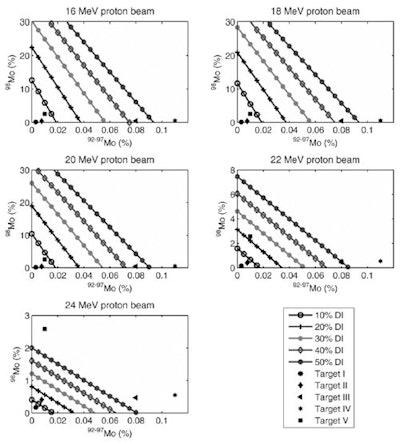 The relationships between a single fraction of Mo-92-97 and Mo-98 in the target and patient dose increases for irradiation energies ranging from 16 to 24 MeV. The positions of the five targets show the patient DI corresponding to each of the target compositions.
The relationships between a single fraction of Mo-92-97 and Mo-98 in the target and patient dose increases for irradiation energies ranging from 16 to 24 MeV. The positions of the five targets show the patient DI corresponding to each of the target compositions.These plots provide a convenient way to roughly estimate DI, in order to eliminate targets that would lead to a DI above the predefined limit before cyclotron runs are performed. Alternatively, using the tabulated values with the algorithm will provide more accurate dose and DI estimates based on the exact composition of a specific target.
"The aim of our work is to define the limits of cyclotron produced Tc-99m production parameters: target composition, beam energy, irradiation time, and product shelf life," Hou said. "This study addresses molybdenum composition based on the estimated patient dose increase. A second study, investigating the influence of technetium impurities on diagnostic image quality, has been completed and the paper is being prepared."
© IOP Publishing Limited. Republished with permission from medicalphysicsweb, a community website covering fundamental research and emerging technologies in medical imaging and radiation therapy.




